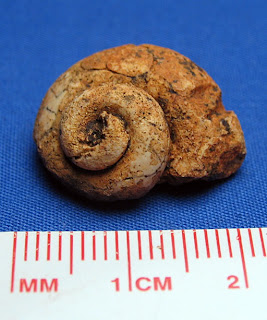Earth History Unit Post-assessment (Earth Science Regents)

Earth History Unit Post-Assessment (Earth Science Regents)
- 1.
A very large, circular impact crater beyond the east coast of Mexico is believed to be approximately 65 million years old. This impact is inferred to be related to (Standard 1.2d):
- A.
Extinction of the dinosaurs
- B.
Appearance of earliest trilobites
- C.
Advance and retreat of the last continental ice sheet
- D.
Formation of Pangaea
- E.
Alien attack
Correct Answer
A. Extinction of the dinosaursExplanation
The correct answer is extinction of the dinosaurs. The given information states that a very large impact crater is believed to be approximately 65 million years old. This aligns with the timeline of the mass extinction event that wiped out the dinosaurs, known as the Cretaceous-Paleogene extinction event. It is widely accepted that this event was caused by a large asteroid impact, and the presence of the impact crater further supports this theory. Therefore, the impact is inferred to be related to the extinction of the dinosaurs.Rate this question:
-
- 2.
This question may require the use of the Earth Science Reference Tables. The Devonian-aged siltstone shown in the photograph below occurs as surface bedrock near Hamilton, New York. What does the presence of the fossils suggest about the Hamilton area during the Devonian? (Standard 1.2f):
- A.
It had a terrestrial environment sometime between 443 and 418 million years ago.
- B.
It had a terrestrial environment sometime between 418 and 362 million years ago.
- C.
It had a marine environment sometime between 443 and 418 million years ago.
- D.
It had a marine environment sometime between 418 and 362 million years ago.
- E.
It had a terrestrial environment sometime between 65 million years ago and the present.
Correct Answer
D. It had a marine environment sometime between 418 and 362 million years ago.Explanation
The presence of Devonian-aged siltstone with fossils suggests that the Hamilton area had a marine environment sometime between 418 and 362 million years ago. This is because the fossils found in the siltstone are indicative of marine organisms that lived during the Devonian period. The age range of 418 to 362 million years ago aligns with the Devonian period, making this the most likely explanation for the presence of the fossils.Rate this question:
-
- 3.
What caused the atmosphere to change through geologic time? (Standard 2.1j)
- A.
The evolution of oxygen-producing organisms
- B.
The formation of the tectonic plates
- C.
The emergence of trilobites
- D.
The deposition of soil during sedimentary rock formation
- E.
Gravity
Correct Answer
A. The evolution of oxygen-producing organismsExplanation
The correct answer is the evolution of oxygen-producing organisms. Over geologic time, the atmosphere has changed due to the emergence and evolution of organisms that are capable of producing oxygen through processes like photosynthesis. These organisms, such as cyanobacteria, were responsible for increasing the levels of oxygen in the atmosphere, leading to significant changes in the composition of the atmosphere and the development of more complex life forms.Rate this question:
-
- 4.
The diagram below shows an index fossil found in surface bedrock in some parts of New York State. In which New York State landscape region is this gastropod fossil most likely found in the surface bedrock? This question may require the Earth Science Reference Tables (Standard 1.2i).
- A.
Allegheny Plateau
- B.
Newark Lowlands
- C.
Adirondack Mountains
- D.
Tug Hill Plateau
- E.
None of the Above
Correct Answer
D. Tug Hill PlateauExplanation
The Tug Hill Plateau is the correct answer because the diagram shows an index fossil found in surface bedrock in some parts of New York State. The Tug Hill Plateau is a region in New York State known for its sedimentary rock formations. Therefore, it is most likely that this gastropod fossil would be found in the surface bedrock of the Tug Hill Plateau.Rate this question:
-
- 5.
Human civilizations developed during which of the following periods of geologic time? This question may require the Earth Science Reference Tables (Standard 1.2i).
- A.
Triassic Period
- B.
Jurassic Period
- C.
Tertiary Period
- D.
Quaternary Period
- E.
Modern Period
Correct Answer
D. Quaternary PeriodExplanation
The Quaternary Period is the correct answer because it is the most recent geologic time period, spanning from about 2.6 million years ago to the present. This period is characterized by the development and evolution of modern human civilizations. It includes the emergence and spread of Homo sapiens, the development of agriculture, the rise of complex societies, and the advancements in technology and culture that have shaped human civilization as we know it today.Rate this question:
-
- 6.
6. Which rock type is the oldest (Standard 1.2j):Type 1:Type 2:Type 3:Type 4:
- A.
Type 1
- B.
Type 2
- C.
Type 3
- D.
Type 4
- E.
All of the rock types are the same age.
Correct Answer
D. Type 4Explanation
The correct answer is Type 4. This is because the question asks for the oldest rock type, and Type 4 is the only option given as an answer that states a specific rock type. The other options do not provide any information about the age of the rock types. Therefore, Type 4 is the correct answer as it is the only option that directly addresses the age of the rock type.Rate this question:
-
- 7.
A fossil shell contains 25% of the original amount of its carbon-14. Approximately how many years ago was this shell part of a living organism? This question may require the Earth Science Reference Tables (Standard 1.2j).
- A.
17,100 years ago
- B.
22,800 years ago
- C.
11,400 years ago
- D.
5,700 years ago
- E.
65 million years ago
Correct Answer
C. 11,400 years agoExplanation
The answer of 11,400 years ago is based on the concept of carbon dating. Carbon-14 is a radioactive isotope that is present in living organisms and decays over time. By measuring the amount of carbon-14 remaining in a fossil, scientists can estimate how long ago it was part of a living organism. In this case, since the fossil shell contains 25% of the original amount of carbon-14, it indicates that approximately 11,400 years have passed since it was part of a living organism.Rate this question:
-
- 8.
Which inference is best supported by the rock and fossil record of New York State? This question may require the Earth Science Reference Tables (Standard 2.1o).
- A.
Eurypterids lived in shallow seas near present day Syracuse.
- B.
The earliest coral reefs formed off the shore of present-day Long Island.
- C.
Coelophysis wandered through the jungles near the present-day Albany
- D.
Condors nested in the Adirondack Mountains during the Grenville Orogeny.
- E.
Wooly mammoths roamed Manhattan during the Precambrian.
Correct Answer
A. Eurypterids lived in shallow seas near present day Syracuse.Explanation
The inference that is best supported by the rock and fossil record of New York State is that Eurypterids lived in shallow seas near present-day Syracuse. This is because the presence of Eurypterid fossils in the rock record indicates that these creatures once inhabited the area. The other statements do not have sufficient evidence from the rock and fossil record to support them.Rate this question:
-
- 9.
Rate, on a scale of 1 � 4, 1 being the lowest and 4 being the highest, how much you already know about the Earth�s History.
Correct Answer
1
2
3
4Explanation
The given answer suggests that the person knows all levels of knowledge about Earth's history, ranging from the lowest (1) to the highest (4). This indicates that the person has a comprehensive understanding of the subject and is familiar with various aspects of Earth's history.Rate this question:
- 10.
Rate, on a scale of 1 � 4, 1 being the lowest and 4 being the highest, how interested are you in Earth�s history.
Correct Answer
1
2
3
4Explanation
This question is asking for the respondent's level of interest in Earth's history. The answer options range from 1 to 4, with 1 being the lowest level of interest and 4 being the highest level of interest. The respondent can choose any combination of the numbers 1, 2, 3, and 4 to indicate their level of interest.Rate this question:
Quiz Review Timeline +
Our quizzes are rigorously reviewed, monitored and continuously updated by our expert board to maintain accuracy, relevance, and timeliness.
-
Current Version
-
Mar 21, 2023Quiz Edited by
ProProfs Editorial Team -
Jan 10, 2011Quiz Created by
Tagscience
- African American History Quizzes
- Age Of Exploration Quizzes
- American History Quizzes
- Asian History Quizzes
- Australian History Quizzes
- Black History Quizzes
- Canadian History Quizzes
- Chinese Dynasty Quizzes
- Chinese History Quizzes
- Civilization Quizzes
- Colonialism Quizzes
- Colonization Quizzes
- Elizabethan Era Quizzes
- European History Quizzes
- French Revolution Quizzes
- Georgia History Quizzes
- Gothic Quizzes
- History Midterm Quizzes
- Indian History Quizzes
- Mesopotamia Quizzes
- Middle Ages Quizzes
- Modern History Quizzes
- Philippine History Quizzes
- Renaissance Quizzes
- Roman History Quizzes
- Slavery Quizzes
- The Rise Of Hitler Quizzes
- United States Constitution Quizzes
- War Quizzes
- Westward Expansion Quizzes
- World History Quizzes
- World War I Quizzes
- World War II Quizzes
 Back to top
Back to top





